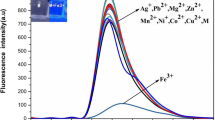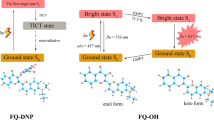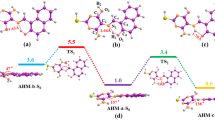Abstract
Aluminum (Al), gallium (Ga) and indium (In) are three essential elements in group IIIA of the periodic tables, which exhibit similar chemical behaviors in aqueous solutions. A novel fluorescent probe 4-hydrazino-7-nitrobenzofurazan-2-hydroxy-1-naphthaldehyde (NBD-hnap) by a simple conjugation of NBD and hnap molecules is found to detect the IIIA group ions based the ‘turn-on’ fluorescent. Here, the sensing mechanisms of probe NBD-hnap to detect IIIA group ions are explored by density functional theory (DFT) and time-dependent DFT (TDDFT) theoretical methods. In aqueous solution, the NBD-hnap has two absorption peaks, and the fluorescence intensity is almost zero during the emission process. After adding IIIA group ions, the absorption spectrum was blue shifted and showed strongly red fluorescence signal. In our calculation, the presence of the C=N bond may induce a twisted intramolecular charge transfer (TICT) state. Thus, the fluorescence quenching of NBD-hnap is caused by TICT process. When NBD-hnap is coordination with metal ions, the TICT state is eliminated.













Similar content being viewed by others
References
Liu D, Zhang M, Du W, Hu L, Li F, Tian X, Wang A, Zhang Q, Zhang Z, Wu J, Tian Y (2018) A series of Zn(II) terpyridine-based nitrate complexes as two-photon fluorescent probe for identifying apoptotic and living cells via subcellular immigration. Inorg Chem 57:7676–7683
Tang JH, Sun Y, Gong ZL, Li ZY, Zhou Z, Wang H, Li X, Saha ML, Zhong YW, Stang PJ (2018) Temperature-responsive fluorescent organoplatinum(II) metallacycles. J Am Chem Soc 140:7723–7729
Denis M, Pancholi J, Jobe K, Watkinson M, Goldup SM (2018) Chelating rotaxane ligands as fluorescent sensors for metal ions. Angew Chem 57:5310–5314
Wen Y, Sheng T, Zhu X, Zhuo C, Su S, Li H, Hu S, Zhu QL, Wu X (2017) Introduction of red-green-blue fluorescent dyes into a metal-organic Framework for tunable white light emission. Adv Mater (Deerfield Beach, Fla.) 29:6405–6410
Jung KH, Oh ET, Park HJ, Lee KH (2016) Development of new peptide-based receptor of fluorescent probe with femtomolar affinity for Cu(+) and detection of Cu(+) in Golgi apparatus. Biosens Bioelectron 85:437–444
Ruan Q, Mu L, Zeng X, Zhao JL, Zeng L, Chen ZM, Yang C, Wei G, Redshaw C (2018) A three-dimensional (time, wavelength and intensity) functioning fluorescent probe for the selective recognition/discrimination of Cu (2+), Hg(2+), Fe(3+) and F(-) ions. Dalton Trans 47:3674–3678
He XJ, Wu CL, Qian YN, Li YH, Zhang LL, Ding F, Chen H, Shen JL (2019) Highly sensitive and selective light-up fluorescent probe for monitoring gallium and chromium ions in vitro and in vivo. Analyst 144:3807–3816
Das B, Dolai M, Dhara A, Ghosh A, Mabhai S, Misra A, Dey S, Jana A (2021) Solvent-regulated fluorimetric differentiation of Al3+ and Zn2+ using an AIE-active single sensor. J Phys Chem A 125:1490–1504
Litov RE, Sickles VS, Chan GM, Springer MA, Cordano A (1989) Plasma aluminum measurements in term infants fed human milk or a soy-based infant formula. Pediatrics 84:1105–1107
Yokel RA, Hicks CL, Florence RL (2008) Aluminum bioavailability from basic sodium aluminum phosphate, an approved food additive emulsifying agent, incorporated in cheese. Food Chem Toxicol 46:2261–2266
Soni MG, White SM, Flamm WG, Burdock GA (2001) Safety evaluation of dietary aluminum. Regul Toxicol Pharm 33:66–79
Doherty RE (2000) A history of the production and use of carbon tetrachloride, tetrachloroethylene, trichloroethylene and 1, 1, 1-trichloroethane in the United States: part 2-trichloroethylene and 1, 1, 1-trichloroethane. Environ Forensics 1:83–93
House E, Esiri M, Forster G, Ince PG, Exley C (2012) Aluminium, iron and copper in human brain tissues donated to the medical research council’s cognitive function and ageing study. Metallomics 4:56–65
Mirza A, King A, Troakes C, Exley C (2017) Aluminium in brain tissue in familial Alzheimer’s disease. J Trace Elem Med Biol Org Soc Miner Trace Elem 40:30–36
Nayak P (2002) Aluminum: impacts and disease. Environ Res 89:101–115
Good PF, Olanow C, Perl DP (1992) Neuromelanin-containing neurons of the substantia nigra accumulate iron and aluminum in Parkinson’s disease: a LAMMA study. Brain Res 593:343–346
Wang F, Gao T, Zhang Q, Hu ZY, Jin B, Li L, Zhou X, Li H, Van Tendeloo G, Zhai T (2018) Liquid-alloy-assisted growth of 2D ternary Ga2 In4 S9 toward high-performance UV photodetection. Adv Mater 56:1806306–1806315
Syed N, Zavabeti A, Ou JZ, Mohiuddin M, Pillai N, Carey BJ, Zhang BY, Datta RS, Jannat A, Haque F, Messalea KA, Xu C, Russo SP, McConville CF, Daeneke T, Kalantar-Zadeh K (2018) Printing two-dimen-sional gallium phosphate out of liquid metal. Nat Commun 9:3618–3627
Pourshahrestani S, Zeimaran E, Kadri NA, Gargiulo N, Jindal HM, Naveen SV, Sekaran SD, Kamarul T, Towler MR (2017) Potency and cytotoxicity of a novel gallium-containing mesoporous bioactive glass/chitosan composite scaffold as hemostatic agents. ACS Appl Mater Interfaces 9:31381–31392
Crunkhorn S (2018) Antibacterial agents: gallium fights infection in phase I trial. Nat Rev Drug Discov. https://doi.org/10.1038/nrd.2018.186
Straus DJ (2003) Gallium nitrate in the treatment of lymphoma. Semin Oncol 30:25–33
Chitambar CR (2004) Gallium nitrate for the treatment of non-Hodgkin’s lymphoma. Expert Opin Investig Drugs 13:531–541
Liu YJ, Tian FF, Fan XY, Jiang FL, Liu Y (2017) Fabrication of an acylhydrazone based fluorescence probe for Al3+. Sensors Actuators B Chem 240:916–925
Liu XM, Qi YT, Pu SH, Wang Y, Gao ZQ (2021) Sensing mechanism of a new fluorescent probe for hydrogen sulfide: photoinduced electron transfer and invalidity of excited-state intramolecular proton transfer. RSC Adv 11:22214–22220
Tang Z, Zhou PW (2020) New insights into the excited state dynamics of quinoline−pyrazole isomerism. J Phys Chem B 124:3400–3407
Yu FS, Guo XF, Tian XJ, Jia LH (2017) A Ratiomeric Fluorescent Sensor for Zn2+ Based on N, N’-Di(quinolin-8-yl)oxalamide. J Fluoresc 27:723–728
Tang Z, Wang Y, Bao DS, Lv MH, Yang Y, Tian J, Dong L (2017) Theoretical investigation of excited-state intramolecular proton transfer mechanism for an asymmetric structure of 3,7-dihydroxy-4-oxo-2-phenyl-4H-chromene-8-carbaldehyde: single or double? J Phys Chem A 121:8807–8814
Noh JY, Kim S, Hwang IH, Lee GY, Kang J, Kim SH, Min J, Park S, Kim C, Kim J (2013) Solvent-dependent selective fluorescence assay of aluminum and gallium ions using julolidine-based probe. Dyes Pigm 99:1016–1021
Yang W, Yang SH, Guo QR (2015) Phenothiazine–aminothiourea–Hg (II) ensemble-based fluorescence turn-on toward iodide in aqueous media and imaging application in live cells. Sensor Actuator B Chem 213:404–408
Hu JH, Li JB, Qi J (2015) Highly selective and effective mercury (II) fluorescent sensors. New J Chem 39:843–848
Liu X, Fu C, Ren X, Liu H, Li L, Meng X (2015) Fluorescence switching method for cascade detection of salicylaldehyde and zinc(II) ion using protein protected gold Nanoclusters. Biosens Bioelectron 74:322–328
Ortega E, Reddy SM, Betancourt I, Roughani S, Stadler BJH, Ponce A (2017) Magnetic ordering in 45 nm-diameter multisegmented FeGa/Cu nanowires: single nanowires and arrays. J Mater Chem C 5:7546–7552
Liu MJ, Yuan J, Tao J, Zhang YQ, Liu CM, Kou HZ (2018) Rhodamine salicy-laldehyde hydrazone Dy(III) complexes: fluorescence and magnetism. Inorg Chem 57:4061–4069
Li YP, Zhao Q, Yang HR, Liu SJ, Liu XM, Zhang YH, Hu TL, Chen JT, Chang Z, Bu XH (2013) A new ditopic ratiometric receptor for detecting zinc and fluoride ions in living cells. Analyst 138:5486–5494
Iniya M, Jeyanthi D, Krishnaveni K, Mahesh A, Chellappa D (2014) Triazole based ratiometric fluorescent probe for Zn2+ and its application in bioimaging. Spectrochim Acta A 120:40–46
Ding WH, Cao W, Zheng XJ, Fang DC, Wong WT, Jin LP (2013) A highly selective fluorescent chemosensor for Al (III) ion and fluorescent species formed in the solution. Inorg Chem 52:7320–7322
He XJ, Wu CL, Qian YN, Li YH, Ding F, Zhou ZH, Shen JL (2019) Symmetrical bis-salophen probe serves as a selectively and sensitively fluorescent switch of gallium ions in living cells and zebrafish. Talanta 205:120118–120126
Park GJ, Park DY, Park KM, Kim YM, Kim SJ, Chang PS, Kim C (2014) Solvent-dependent chromogenic sensing for Cu2þand fluorogenic sensing for Zn2+ and Al3+: a multifunctional chemosensor with dual-mode. Tetrahedron 70:7429–7438
Zheng QX, Ding F, Hu XJ, Feng JY, Shen JL, He XJ (2021) ESIPT-based fluorescent probe for bioimaging and identification of group IIIA ions in live cells and zebrafish. Bioorg Chem 109:104746–104754
Becke AD (1993) Density-functional thermochemistry 0.3. The role of exact exchange. J Chem Phys 98:5648–5652
Lee CT, Yang WT, Parr RG (1988) Development of the Colle-Salvetti correlation-energy formula into a functional of the electron density. Phys Rev B Condens Matter 37:785–789
Miehlich B, Savin A, Stoll H, Preuss H (1989) Development of the Colle-Salvetti correlation-energy formula into a functional of the electron density. Chem Phys Lett 157:200–206
Schafer A, Horn H, Ahlrichs R (1992) Fully optimized contracted Gaussian basis sets for atoms Li to Kr. J Chem Phys 97:2571–2577
Schafer A, Huber C, Ahlrichs R (1994) Fully optimized contracted Gaussian basis sets of triple zeta valence quality for atoms Li to Kr. J Chem Phys 100:5829–5835
Weigend F, Ahlrichs R (2005) Balanced basis sets of split valence, triple zeta valence and quadruple zeta valence quality for H to Rn: design and assessment of accuracy. Phys Chem Chem Phys 7:3297–3305
Frisch MJ, Trucks GW, Schlegel HB, Scuseria GE, Robb MA, Cheeseman JR, Scalmani G, Barone V, Petersson GA, Nakatsuji H, Li X, Caricato M, Marenich AV, Bloino J, Janesko BG, Gomperts R, Mennucci B, Hratchian HP, Ortiz JV, Izmaylov AF, Sonnenberg JL, Williams-Young D, Ding F, Lipparini F, Egidi F, Goings J, Peng B, Petrone A, Henderson T, Ranasinghe D, Zakrzewski VG, Gao J, Rega N, Zheng G, Liang W, Hada M, Ehara M, Toyota K, Fukuda R, Hasegawa J, Ishida M, Nakajima T, Honda Y, Kitao O, Nakai H, Vreven T, Throssell K, Montgomery Jr JA, Peralta JE, Ogliaro F, Bearpark MJ, Heyd JJ, Brothers EN, Kudin KN, Staroverov VN, Keith TA, Kobayashi R, Normand J, Raghavachari K, Rendell AP, Burant JC, Iyengar SS, Tomasi J, Cossi M, Millam JM, Klene M, Adamo C, Cammi R, Ochterski JW, Martin RL, Morokuma K, Farkas O, Foresman JB, Fox DJ (2016) M. A. Gaussian 16, Revision C. 01, Gaussian, Inc., Wallingford, CT
Cances E, Mennucci B, Tomasi J (1997) A new integral equation formalism for the polarizable continuum model: theoretical background and applications to isotropic and anisotropic dielectrics. J Chem Phys 107:3032–3041
Cammi R, Tomasi J (1995) Remarks on the use of the apparent surface charges (ASC) methods in solvation problems: iterative versus matrix-inversion procedures and the renormalization of the apparent charges. J Comput Chem 16:1449–1458
Miertus S, Scrocco E, Tomasi J (1981) Electrostatic interaction of a solute with a continuum. A direct utilizaion of AB initio molecular potentials for the prevision of solvent effects. Chem Phys 55:117–129
Lu T, Chen FW (2012) Multiwfn: a multifunctional wavefunction analyzer. J Comput Chem 33:580–592
Garcia JC, Johnson ER, Keinan S, Chaudret R, Piquemal JP, Beratan DN, Yang WT (2011) NCIPLOT: a program for plotting non-covalent interaction regions. J Chem Theory Comput 7:625–632
Johnson ER, Keinan S, Mori-Sanchez P, Contreras-Carcia J, Cohen AJ, Yang WT (2010) J Am Chem Soc 132:6498–6506
Liu ZY, Lu T, Chen QX (2020) An sp-hybridized all-carboatomic ring, cyclo[18]carbon: Electronic structure, electronic spectrum, and optical nonlinearity. Carbon 165:461–467
Yin H, Li H, Xia G, Ruan C, Shi Y, Wang H, Jin M, Ding D (2016) A novel non-fluorescent excited state intramolecular proton transfer phenomenon induced by intramolecular hydrogen bonds: an experimental and theoretical investigation. Sci Rep 6:19774–19782
Guido CA, Cortona P, Mennucci B, Adamo C (2013) On the metric of charge transfer molecular excitations: a simple chemical descriptor. J Chem Theory Comput 9:3118–3126
Mayer I (1983) Charge, bond order and valence in the AB initio SCF theory. Chem Phys Lett 97:270–274
Acknowledgements
This work was supported by the Open Project of SKLMRD (the open fund of the state key laboratory of molecular reaction dynamics in DICP, CAS) and the General Program from Education department of Liaoning Province (Grant LJKZ0534).
Author information
Authors and Affiliations
Corresponding author
Additional information
Publisher's Note
Springer Nature remains neutral with regard to jurisdictional claims in published maps and institutional affiliations.
Supplementary Information
Below is the link to the electronic supplementary material.
Rights and permissions
About this article
Cite this article
Liu, X., Zhang, H., Zhang, Y. et al. Elaborating the mechanism of a highly selective fluorescent ‘turn-on’ probe to detect the group IIIA ions: a detailed time-dependent density functional theory study. Theor Chem Acc 141, 37 (2022). https://doi.org/10.1007/s00214-022-02892-8
Received:
Accepted:
Published:
DOI: https://doi.org/10.1007/s00214-022-02892-8




